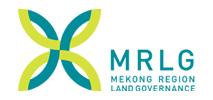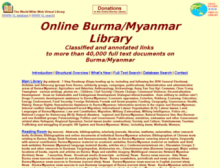Resource information
This report presents a political-economic analysis of
land governance at the regional level, focusing on the
Mekong Region
The primary emphasis is on Cambodia,
Laos, Myanmar and Vietnam (CLMV), but the paper also
takes into account the regional role and land governance
experiences of Thailand and China. The report is one in
a series of reports on Cambodia, Laos, Myanmar and
Vietnam that present country-level analyses of the poli-
tical economy of land governance. The series is part of
a research mapping and political-economic analysis
conducted by the authors for the Mekong Region Land
Governance (MRLG) project, funded by the Swiss Agency
for Development Cooperation (SDC) and the German
Agency for International Cooperation (GIZ). The initiative
is driven by concerns about security of tenure of small-
holder farmers, ethnic minorities and women, against a
background of land grabbing in various guises (see
www.mrlg.org)...
In this case, the Mekong is broadly coterminous with mainland Southeast Asia. While it takes the river as its defining motif, the region is much wider than the Mekong River
and its tributaries. Alternatively framed, the Greater Mekong Sub-region is comprised of Cambodia, Laos, Myanmar, Thailand, Vietnam and the two provinces of China that
border Southeast Asia (Yunnan and Guangxi). The project-specific definition of the region behind this report includes the CLMV countries. Sometimes referred to as the
Association of Southeast Asian Nations (ASEAN) latecomers, the once-socialist economies seek to integrate and capitalise their economies. In the context of land-based
investment with which the report is concerned, Thailand and China enter as important players – providing a more complete picture of the region.
2
Political Economy of Land Governance in the Mekong Region
A Food and Agriculture Organization of the United Nations
(FAO) report defines “land governance” succinctly as
follows:
“Land governance concerns the rules, processes and
structures through which decisions are made about
access to land and its use, the manner in which the
decisions are implemented and enforced, the way that
competing interests in land are managed” (Palmer et
al. 2009: 9).”
Our working definition expands on the FAO definition as
follows:
“Land governance consists of the means by which
authority is wielded and collective action applied in
order to achieve particular social and economic out-
comes through land use, distribution, access and
security. Land governance is concerned with processes,
institutions, laws, practices and structures of power
involving a diverse range of public and private actors.”
Land governance is a scaled issue, involving broad level
influences at the global, regional, national and local
scales. This paper seeks to explain the main parameters
of land governance at the regional scale, with a particular
focus on the Mekong Region. Our project of conducting
a regional political-economic analysis considers the
questions: Why apply political economy to an analysis
of land governance, and what does a regional scale
analysis entail? In other words, what makes land govern-
ance a political-economic issue, and what makes it a
regional issue?
LAND GOVERNANCE: A POLITICAL-
ECONOMIC ISSUE
Not all approaches to land governance place it in the
realm of political economy per se. Land governance
can be approached from a number of angles. In a uni-
versal and normative sense “good land governance”
is sought through a range of global level assessment
criteria (see, for example, The Land Governance
Assessment Framework: Identifying and Monitoring
Good Practice in the Land Sector, Deininger et al.
2011). The FAO has established a set of non-binding
guidelines for “responsible” governance of land tenure
and other natural resources (FAO 2012). A number of
development assistance initiatives funded by Australian,
German, Finnish, Canadian, Swiss (and other) bilateral
development agencies have sought to improve land
governance in the Mekong Region by programmatic
means (see www.landgov.donorplatform.org). Each of these
frameworks has its own emphasis; some are
more market-oriented and some are geared to a liberal
rights-oriented approach of social inclusion. However,
all work within broad “good governance” criteria of
transparency, rule of law, stakeholder inclusion and
equitable market structures. While there is recognition
of the need to adapt global concepts and criteria of
‘good
governance’ to country
circumstances, the political-
economic embeddedness of land issues has often been
overlooked.
Only recently have some donors specifically sought to
conduct political-economic analysis in recognition of
program risks and failures attributed to insufficient
account being taken of the context within which programs
operate. For example, responding to the World Bank
Inspection Panel that investigated the Land Management
and Administration Project in Cambodia, Management of
LMAP noted:
“With the benefit of hindsight, Management recognises
that ... a more detailed analysis of the political economy
context would likely have identified ... that... numerous
actors had strong incentives not to proceed with a trans-
parent and public interest based classification and
registration of State land” (IBRD & IDA, 21 January,
2011, p. 15...



